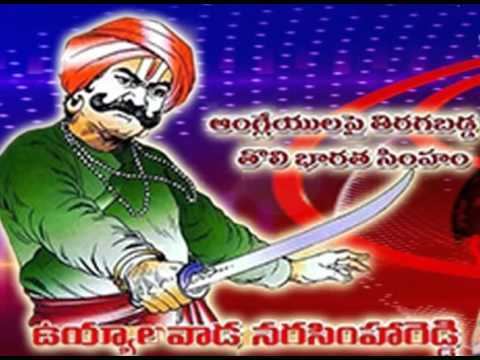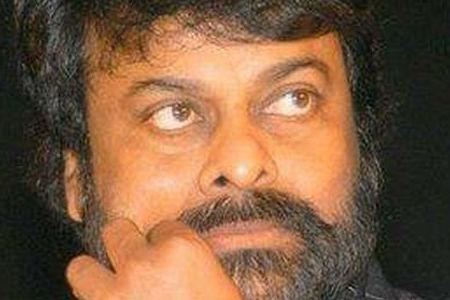Parents Peda Malla Reddy Children Dora Subba Reddy | Cause of death Hanging | |
Spouse(s) Three wives. First wife name Siddamma Died 22 February 1847, Koilkuntla | ||
Uyyalawada Narasimha Reddy (died 1847) is credited to be one of the first freedom fighters in India. His was the first revolt in India against the British occupation, 10 years earlier than India's First War of Independence (term) of 1857 also known as Indian Rebellion of 1857. Nearly 60 villages were under the control of Reddy, including Uyyalawada, Gulladurti, Harivaram,narsipalle,pampalle, Uppaluru,koilakuntla, Kotthakota. The ruins of the fort at Kotthakota can still be seen. Now these villages are in Prakasam,Kurnool,Kadapa (or Cuddapah), Anantapur districts of Andhra Pradesh and in the Ballari region of Karnataka.[4]. Renati simham a Telugu novel by Dr.P.DamodaraReddy
Contents
- Balakrishna venkatesh launch uyyalawada narasimha reddy audio tv9 exclusive
- Early life
- Background and uprising
- Capture and death
- Monuments
- Memorial committee
- Memorial Committee for The Sun and Moon of Renadu
- References
Balakrishna venkatesh launch uyyalawada narasimha reddy audio tv9 exclusive
Early life

Uyyalawada Narasimha Reddy was born to Uyyalawada Peddamalla Reddy in Uyyalawada, located in the present-day Kurnool district which is on the banks of Kundu River. His father Peddamalla Reddy and his grandfather Jayarami Reddy were local chieftains (Polygars) of Koilakuntla.
He built a fort at Kottakota village near Giddalur. The ruins of the fort can still be seen at Kottakota.
Background and uprising

Narasimha Reddy, as a Polygar of Koilakuntla was in command of 66 villages in Cuddapah (or Kadapa), Anantapur, Bellary and Kurnool districts and controlled an army of 2000. After Rayalaseema was ceded to the British by the Nizam, Narasimha Reddy refused to share the revenue of the region with the British. He was in favour of an armed uprising. On 10 June 1846 he attacked the treasury at Koilakuntla and marched towards Kambham, Andhra Pradesh (Prakasam District). On the way, he created uproar at Rudravaram by killing the forest ranger. The district collector, Thomas Monroe, took a serious view of the rebellion and ordered his capture. Early attempts to capture him under Captain Knot and Watson were unsuccessful. The British government announced Rs 5,000/ for the information and Rs 10,000/ for his head which was a huge amount in those days.
Capture and death
Narasimha Reddy with his army attacked the British forces camped at Giddaluru on 23 July 1846 and defeated them. Unable to capture him, the British imprisoned his family at Kadapa. In an attempt to free his family, Narasimha Reddy moved to Nallamala forest. Someone in the village informed this to the Collector of koilakuntla. When the British tightened his movements in the Nallamala region, Narasimha Reddy came back to Koilkuntla area and hid in Jagannatha Konda near the village of Ramabhadrunipalle. An informant brought to the notice of British authorities of his whereabouts and his followers. The area was surrounded by armed forces at night. He was caught at midnight of 6 October 1846. Narasimha Reddy was humiliated before being brought to Koilkuntla. He was tied with heavy chains and paraded in the streets of Koilkuntla with blood-stained clothes so that none should dare to revolt against the British.
As many as 901 people were charged along with Narasimha Reddy for this uprising. Later 412 of them were acquitted and 273 were released on bail. As many as 112 were convicted and sentenced to imprisonment for 5 to 14 years. Some were sent to a prison in the Andaman Islands. The younger brother of the rulers of Auk is one of them. The special commissioner of Cuddapah conducted the trial. Narasimha Reddy was charged with revolt, murder and dacoity and convicted on all charges. He was sentenced to death by hanging. On 22 February 1847, Reddy was hanged publicly by the British in Koilkuntla on the banks of a nearby river in the presence of collector Kokcrane.
In order to terrorize the other freedom-fighters, his head was kept hanging to the fort of Koilakuntla for about 30 years after his death (that is from 1847 to 1877)
Monuments
Forts built by Narasimha Reddy still exist at places like Nossam,Uyyalawada, Rupanagudi,kristipadu, Uppaluru and Giddaluru. His story is alive in Rayalaseema particularly Kurnool and Kadapa districts
Memorial committee
A committee was formed to develop Jagannatha Konda as a memorial monument of Uyyalawada Narasimha Reddy. The committee consists of eminent political personalities. Silpa Chakrapani Reddy is honorary president to the committee. Kaipa Prathap Reddy, Kasipuram Prabhakara Reddy, Gangula Janardhan Reddy, Palukuru Gopal Reddy and many local leaders were founding members. There are plans to erect a statue of Narasimha Reddy and to publish the historical importance of the site.
Memorial Committee for The Sun and Moon of Renadu
A committee (Renati Surya Chandrula Smaraka Samithi) was formed to preserve the memory of two great leaders of that time (Uyyalawada Narasimha Reddy and the Philanthropist Budda Vengal Reddy, both were born in Uyyalawada village). Sri Pocha Brahmananda Reddy is the founding president of this committee.
A book (both in Telugu and English languages) titled "Renati Surya Chandrulu (The Sun and Moon of Renadu) was published by this committee in 2015 (5th Edition of Telugu version was published on 22-Feb-2016). It contains the excerpts from research papers by eminent historians and from the archives of "East India Company" during 1846–1847.
Sri Pocha Brahmananda Reddy interacted with Sri Narendra Modi, Prime Minister of India, personally presented these books and other details to Sri Narendra Modi and Sri Venkaiah Naidu, Minister for Urban Development, when they visited Tirupati and requested them to include the life story of Narasimha Reddy in the textbooks for school children. Results of these efforts, the biography of Narasimha Reddy was included in the textbook for 6th class students in Andhra Pradesh.
